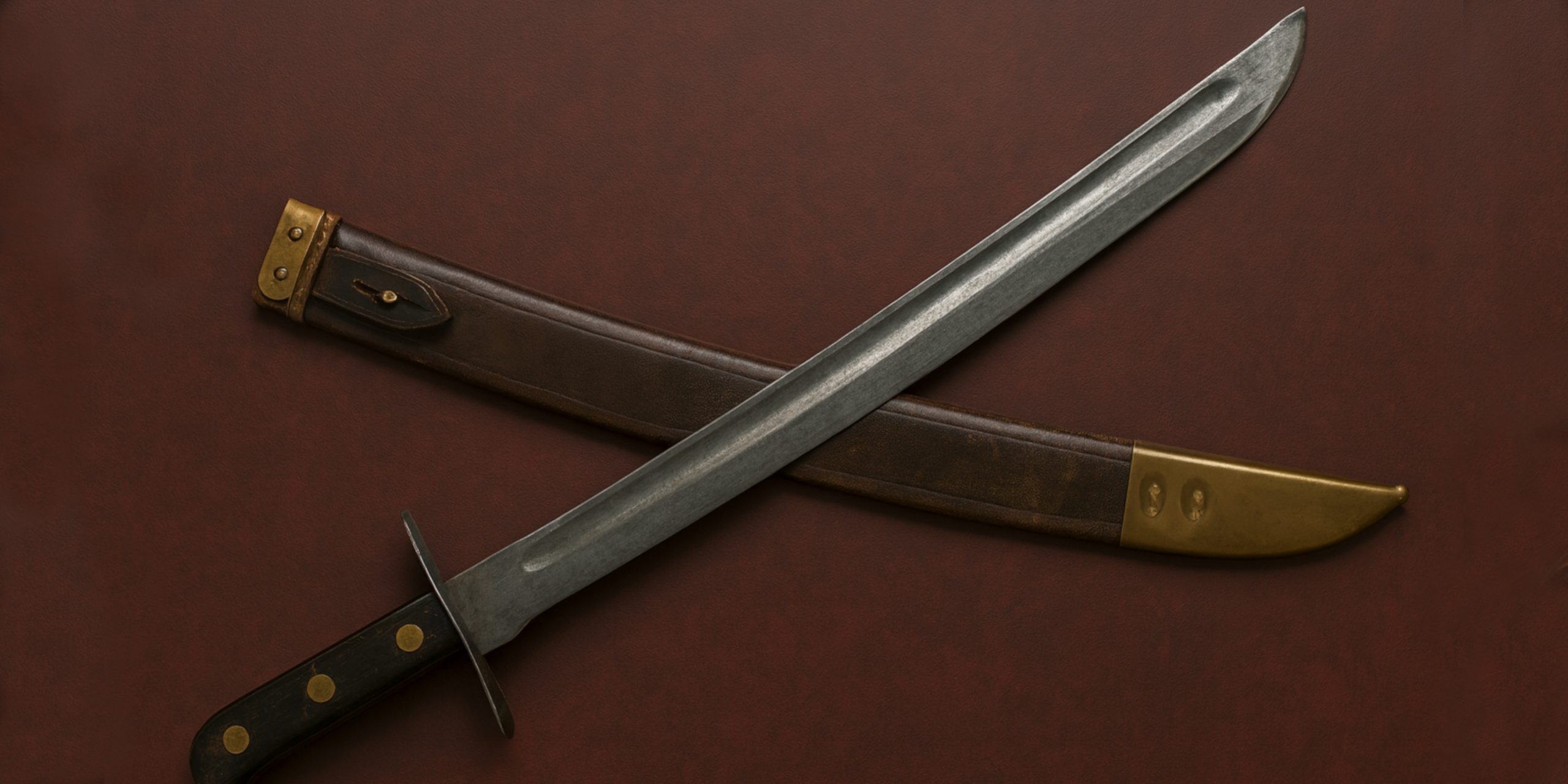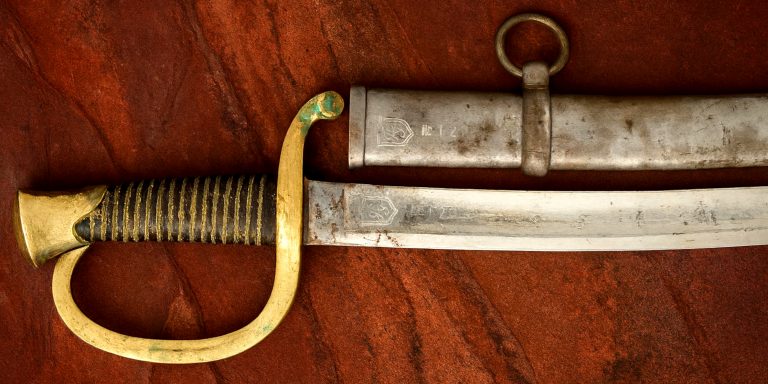
The Dutch colonial hanger sword, also known as a “klewang” in some contexts, was a short, single-edged weapon commonly used by Dutch forces in their colonial territories, particularly in Southeast Asia during the 17th to 19th centuries. This utilitarian yet often finely crafted blade was associated with both naval forces and colonial troops, and adapted over time to the needs of close-quarters combat in jungle and urban environments. It straddled the line between cutlass, machete, and sabre.
Specifications
| Feature | Details |
|---|---|
| Blade length | Typically 55–70 cm |
| Overall length | Approximately 70–85 cm |
| Blade type | Single-edged, slightly curved |
| Hilt | Brass or iron guard, often knucklebow type |
| Grip | Wood, horn, or wrapped leather |
| Pommel | Often flat or slightly flared |
| Weight | Between 0.8 and 1.2 kg |
| Sheath | Leather with brass or iron fittings |
History and Evolution
- 17th Century Origins
The hanger sword design was brought to the colonies through Dutch East India Company forces. Early models were heavily influenced by European naval cutlasses and infantry hangers. - Adaptation in the Indies
The klewang variant emerged in the Dutch East Indies (now Indonesia), reflecting local craftsmanship and materials. The blade became slightly shorter and more curved, making it more effective in dense terrain. - 19th to Early 20th Century Standardisation
In response to local resistance, particularly during the Aceh War (1873–1904), the Dutch Army adopted the Marechaussee klewang as a standard weapon for military police, combining the hanger’s profile with aspects of sabres and machetes. - Later Use and Legacy
The klewang remained in use well into the 20th century, including World War II. It became a symbol of colonial enforcement, but also a practical jungle warfare tool.
Advantages and Disadvantages
Advantages
- Compact and manoeuvrable, ideal for jungle warfare
- Durable construction suited for both combat and utility
- Could deliver effective slashing strikes in confined spaces
- Simple to maintain and sharpen
- Lightweight compared to sabres and broadswords
Disadvantages
- Less effective at thrusting or fencing manoeuvres
- Shorter reach than standard military swords
- Blades often lacked fine balance or refinement in later mass-produced models
- Limited use outside specific colonial contexts
Comparison with Similar Weapons
| Weapon | Origin | Blade Length | Use Case | Comparison with Dutch Hanger |
|---|---|---|---|---|
| Naval Cutlass | Britain / France | 60–75 cm | Shipboard combat | Similar in shape; hanger is lighter and often more curved |
| Sabre | Europe | 80–100 cm | Cavalry and officers | Sabre is longer and designed for mounted use |
| Machete | Global | 40–60 cm | Utility and bush-clearing | Machete is broader and lacks the handguard |
| Klewang (Indonesian) | Southeast Asia | 50–70 cm | Combat and ritual | Virtually identical; local version often more ornate |
Legacy
The Dutch colonial hanger and its klewang variants are historically significant as hybrid weapons blending European and Southeast Asian design sensibilities. They reflect the military, cultural, and political complexities of the Dutch colonial era. Today, they are valued by collectors and historians alike for their functional design and symbolism.
- Used by both colonisers and local troops under Dutch command
- Remains an icon of colonial-era military policing
- Influenced post-colonial designs in Indonesia and beyond
- Sometimes appears in ceremonial contexts and parades
Where to See
- Legermuseum (Delft, Netherlands)
Displays several models of Dutch military swords, including klewangs and colonial hangers. - Tropenmuseum (Amsterdam)
Focuses on Dutch colonial history and includes weaponry. - Indonesian National Museum (Jakarta)
Holds klewangs and local interpretations of the hanger. - Royal Museum of the Armed Forces and Military History (Brussels)
Occasionally features colonial weapons used by European powers.
Collector’s Guide
What to Look For:
- Original brass fittings and scabbards
- Markings indicating unit or colonial issue
- Blades with manufacturer stamps (Solingen, Hembrug, etc.)
- Hilt condition and originality (many were later regripped)
Common Variants:
- Marechaussee klewang (KNIL issue)
- Dutch naval hanger
- Officer variants with decorated blades or engraved guards
Recent Auction Prices:
| Item Type | Condition | Sale Price (GBP) | Notes |
|---|---|---|---|
| Marechaussee klewang (c. 1900) | Good | £350–£500 | Complete with scabbard |
| Naval hanger (early 19th c.) | Fair | £200–£300 | Slight corrosion on guard |
| Officer’s klewang (engraved) | Excellent | £700–£1,100 | Often features decorative etching |
| Indonesian klewang (mid-1800s) | Varies | £150–£400 | Craftsmanship varies significantly |
Buying Tips:
- Be cautious of reproductions or parts swords
- Verify provenance, especially with colonial markings
- Condition of the blade and guard heavily influences value
- Early pieces are rarer and typically more valuable than 20th-century models
For collectors, historians, and enthusiasts, the Dutch colonial hanger represents a weapon shaped by conflict, terrain, and the pragmatic demands of empire. Its enduring form speaks to both its utility and the long shadow of colonial warfare.



